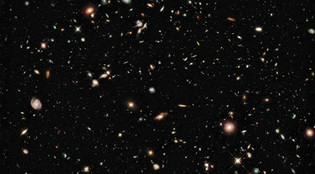 loading
loading
FindingsThe bluest galaxies NASAView full imageYale astronomer Pieter van Dokkum and an international research team have used a newly installed camera on the Hubble Space Telescope to capture the earliest available portrait of the universe. The image, revealed at the January 5 meeting of the American Astronomical Society, shows a region of the cosmos as it existed 13 billion years ago, a “mere” 600 to 900 million years after the Big Bang. The picture is marked by small galaxies about one-twentieth the diameter of the Milky Way. Van Dokkum called them “the seeds that will grow into the large galaxies we see today.” A bonus for deep-dyed Blues: the principal color of those early galaxies is blue, a sign that near the beginning, galaxies were hot and growing fast. But because the telescope took the picture from so far away, the early galaxies don’t appear blue in the images; in this photograph, they are the faintest red dots visible.
The comment period has expired.
|
|